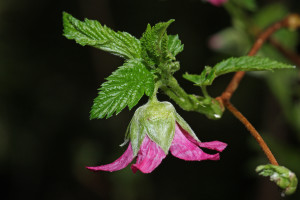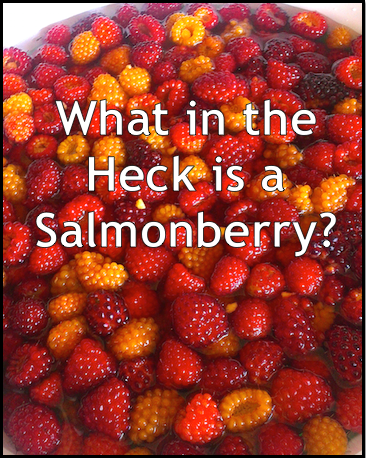For those who don’t live in the Pacific Northwest, hearing about salmonberries for the first time can cause some hilarious reactions. Recently, I was posting on Facebook about making salmonberry jam and some of the questions were highly amusing. No, they are not salmon eggs. They are not salmon mixed with berries (though the Alaskan Natives did mix the two!). They are an edible berry that grows on large bushes.
Rubus Spectabilis if you want to get technical, is a variety of berry that looks a lot like a raspberry but tastes nothing like any other berry out there. They have huge seeds and lots of them. They aren’t really dehydrated due to the high water content but it can be done. They are found from California to Alaska but I have noted in my travels that they grow best and biggest in the Pacific Northwest. They absolutely love all the rain and coastline here. Many people consider them to be a royal pain in the garden shed because they are very hard to get rid of. When you cut the bushes back, they return more lush and take over a larger area than before. You have to be very serious about getting rid of them. It pretty much requires you to dig down and try to get that root system broken up. That can also backfire.

They are the first edible berry of the season here with the flowers forming in April and opening in early May. They give off a light, sweet scent when it rains. As a child, we learned early on that there is sweet nectar in the middle of them. There would be flower petal trails and piles all over the place every summer! When I owned my walking tour company, I would tell the tourists about them and let them try it if they wanted to. It was always well received in both flower and berry form.
Ranging in color from a bright orange to a deep red, the flavor is described as mostly tart. I have found that the orange ones are sweeter than the red ones. According to the Wiki article, the orange ones are also called “Russian Berries” on Kodiak Island. They make for a wonderful treat when out hiking early in the season but bears like them, too. I have heard more than one story of people out picking berries in the wilds and come across a bear sitting in the middle of a large patch, stripping berries off the branches, just as happy as can be. Thankfully, I’ve not heard of anyone being attacked from these encounters (likely due to a lack of cubs around and the bear eating his fill anyway).
I mostly see people using them to make jams and jellies with. I personally make a Cinnamon Salmonberry jam with them that is highly requested by friends and family. Many people cannot eat or simply don’t like all those seeds so they make jelly out of it instead. You can also make syrup with or without seeds. When it comes to making jam, a large amount of orange foam forms on top of the mixture that needs to be spooned off. It does not hurt the taste or look of the jam (that I have noticed, anyway) but it can cause the jam to set with a weird look to it. I also like to make a triple berry jam that is made with salmonberries, blueberries, and huckleberries. It is absolutely decadent! Making salmonberry jam was one of my first forays into water bath canning (it is SO easy!).
So there you have it: a short introduction to what a salmonberry is. 🙂





Would love to get that jelly recipe, I just found a Thatch of berries on my property, I’m thinking of digging a plant up and bringing it to my yard so I can get to the berries before the racoon’s!
I use a recipe that calls for an incredible amount of sugar so you may not like it but here goes.
1 cup berries to 3/4 cup sugar. 4 cups berries to 3 cups sugar. If the salmonberries are particularly watery, it will take longer to cook down (more constant stirring). I also add in some powdered pectin to help thicken it. I tried to go pectin-less one time and ended up with overly sugared salmonberry syrup. Of course, we used it stirred in oatmeal and drizzled over ice cream but when you’re going for jam and end up with syrup, it’s still a bummer. Hope this helps!
BE WARNED: Salmonberries are an extremely aggressive plant. They will spread faster than you can imagine and, once set, are very hard to truly get rid of. They are basically a weed with edible berries haha!